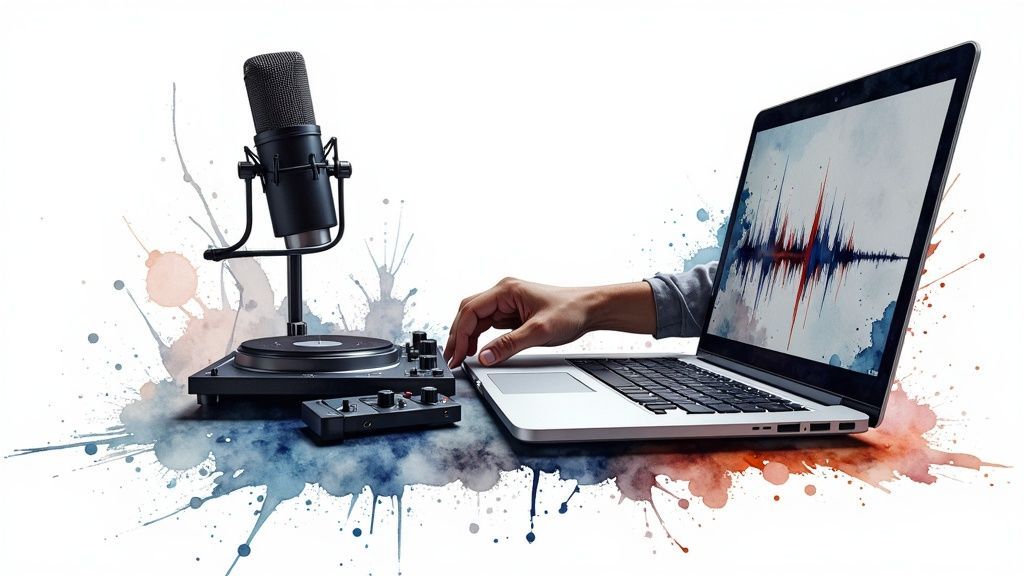
So, what exactly is audio production? In the simplest terms, it’s the entire process of taking a sound from an initial idea all the way to a finished, polished recording. It's the journey from a melody humming in a songwriter's head to a track ready for Spotify, or from a concept for a sound effect to the final boom you hear in a video game.
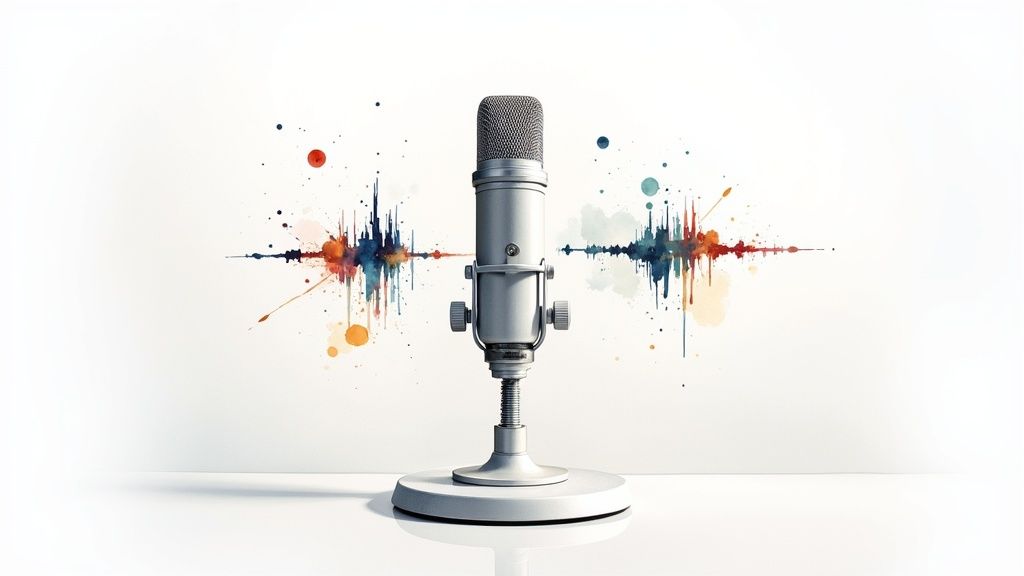
A great way to think about it is to compare it to filmmaking. A director doesn't just show up on set, point a camera, and yell, "Action!" They're involved in everything: scripting, casting, shooting, editing, adding visual effects, and sound design. Audio production is the exact same kind of multi-stage craft, just for the world of sound.
It's so much more than just hitting the record button. It’s a delicate blend of art and science—capturing raw sound, carefully editing it, artistically mixing it, and then putting the final technical polish on it. The goal is always to create a professional and emotionally compelling listening experience.
Every single polished sound you hear in modern media, whether it's the crisp dialogue in a podcast, the subtle ambience in a film, or a massive explosion in a blockbuster movie, has been guided through this meticulous process.
At its heart, the entire audio production workflow can be broken down into four distinct stages. Each one has a clear purpose and builds on the one before it. Once you get a handle on these four pillars, the whole process starts to make a lot more sense.
Here’s a quick overview of what happens at each step of the journey.
| Stage | Primary Goal | Key Activities |
|---|---|---|
| Pre-Production | Plan and prepare for the recording session. | Songwriting, arranging, choosing mics, setting up the studio. |
| Recording (Tracking) | Capture the best possible performance. | Recording instruments and vocals, creating Foley or sound effects. |
| Mixing | Blend all individual tracks into a cohesive whole. | Adjusting levels, panning, EQ, compression, adding effects. |
| Mastering | Polish the final mix for commercial release. | Final EQ, loudness optimization, ensuring playback consistency. |
From planning the session to putting the final touches on the master, each phase is essential for achieving a professional result that connects with listeners.
To really set your project up for success, it all starts with getting the best possible sound at the source. Understanding the best audio recording practices is non-negotiable for creating a strong foundation for the rest of the production process.
To really wrap your head around audio production, it helps to think of it like making a fantastic meal. It’s a step-by-step process where each stage builds on the one before it, all working toward a delicious final product. If you just throw all the ingredients in a pan at once, you’ll end up with a mess. The same goes for sound—a structured approach is what separates a polished, professional track from a messy amateur recording.
This process breaks down into four key phases: pre-production, recording, mixing, and mastering. While some smaller projects might blur the lines between these steps, understanding each one individually gives you a clear roadmap for turning a raw idea into something the world is ready to hear.
The first real hands-on stage is recording, often called tracking. This is where you capture the raw ingredients for your project—the foundational performances, dialogue, or sound effects that will form the heart of your track. The main goal here is to get the cleanest, highest-quality take you possibly can. Why? Because you can't truly "fix" a bad recording later on without making some serious compromises.
Think of it as shopping for the best possible produce for your meal. A great performance captured with the right microphone in a good-sounding room makes every following step smoother and more effective. Just as a chef wouldn't start with wilted lettuce, a smart producer avoids working with noisy, distorted, or flat-out uninspired audio.
Once all your audio "ingredients" are recorded, the prep work begins. In the audio world, this is the editing stage. Here, you take those raw recordings and start cleaning them up and arranging them into a coherent structure. It’s the sonic equivalent of chopping vegetables, trimming fat, and getting everything organized on your prep station.
This involves a few critical tasks:
This infographic breaks down how these phases fit together in the bigger picture.
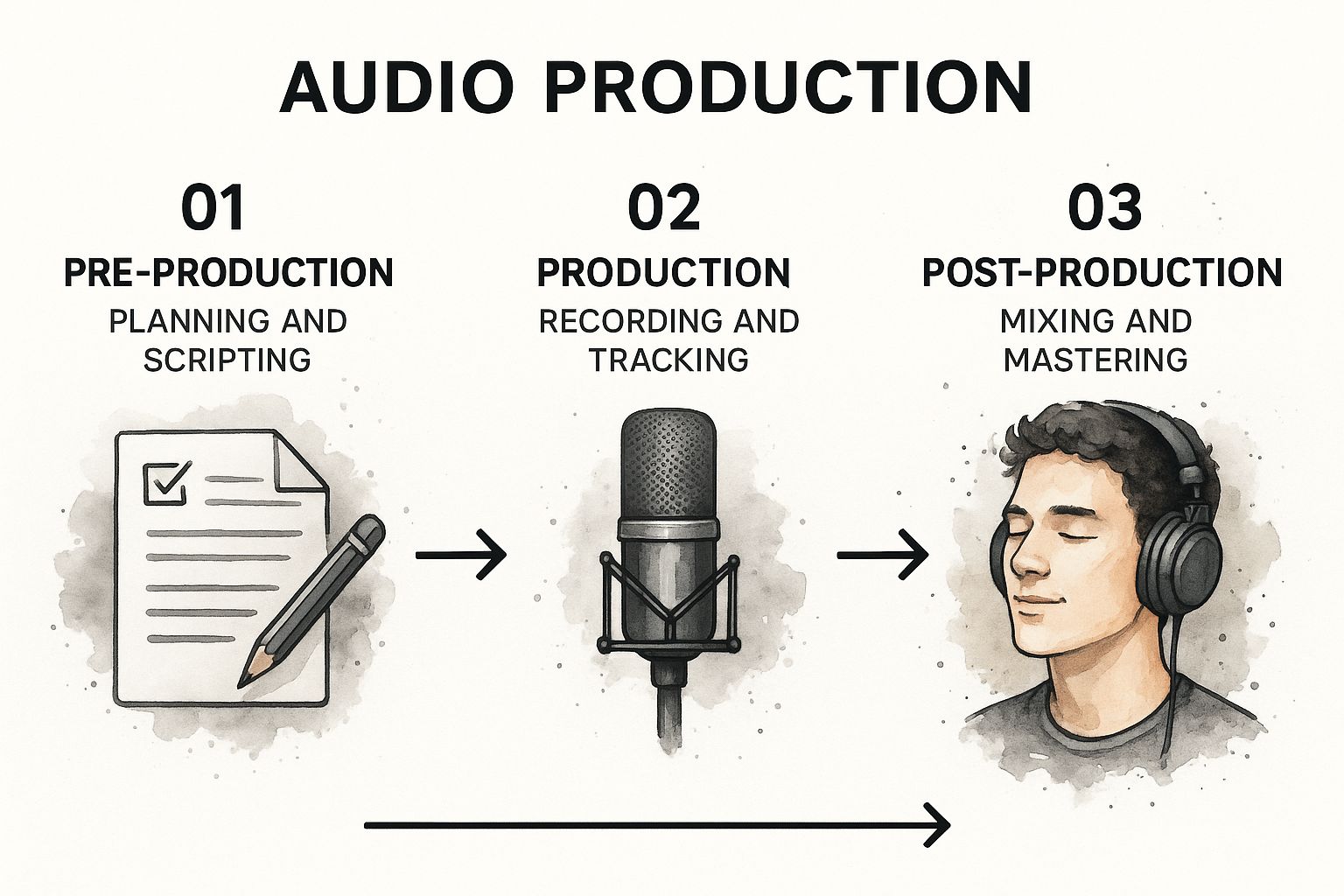
As you can see, the process flows logically from one stage to the next, with the post-production work (editing, mixing, mastering) building directly on the quality of the initial recording.
With all your elements prepped and arranged, it's finally time to start cooking. This is the mixing stage—and for many, it's the most creative and artistic part of the entire process. Mixing is all about blending the individual tracks into one cohesive and emotionally resonant experience. You're balancing levels, adjusting tones, and creating a sense of space for every single sound.
During mixing, you're not just sliding faders up and down; you are sculpting a three-dimensional soundscape. You decide what needs to be front and center, what should create atmosphere in the background, and how all the parts interact to serve the project's overall vision.
This is where you'll use tools like equalization (EQ), compression, and reverb to give each element its own space. For example, you might use an EQ to carve out a little pocket of frequencies for the vocals so they don't get smothered by the electric guitars. Or you might use a compressor to tame a wild bass performance, making it feel solid and consistent throughout the track. The goal is always a balanced, clear, and powerful mix that connects with the listener.
Finally, after your dish has been cooked to perfection, it’s time for the final presentation. This is mastering. As the very last step in the audio production chain, mastering is where the final stereo mix gets polished for distribution. It's the ultimate quality control check that ensures your audio sounds fantastic everywhere, from a listener's earbuds to a massive club sound system.
Mastering engineers make small but crucial adjustments to the overall track. They focus on things like the final tonal balance, stereo width, and overall loudness, ensuring the track is competitive with other commercial releases without crushing its dynamic life. This final touch provides the professional sheen that makes a track truly ready for release. The entire journey, especially these critical finishing stages, is explored in our guide to a professional audio post production workflow, which dives even deeper into the details.
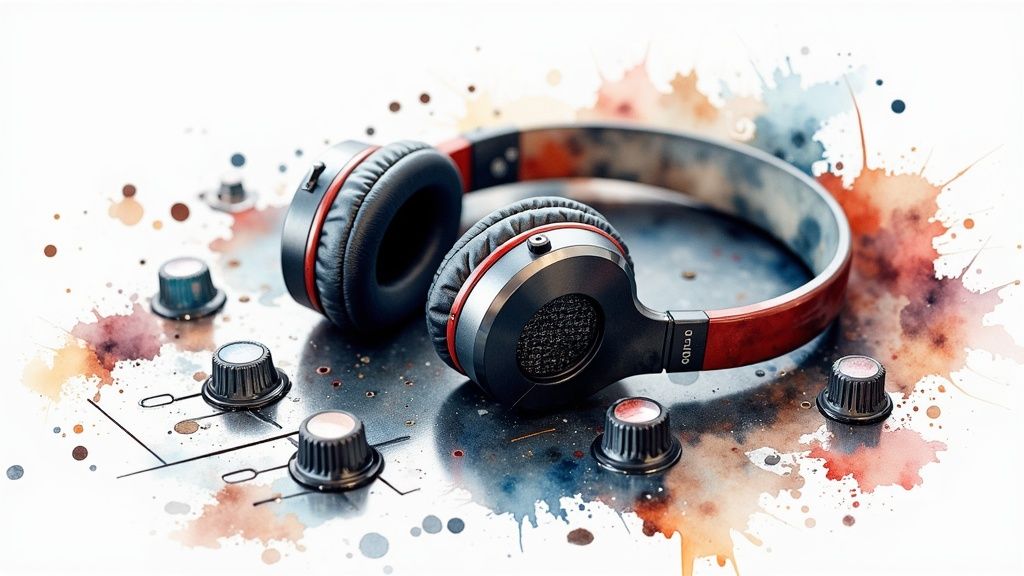
Getting started in audio production today looks a lot different than it used to. You don't need to rent out a million-dollar studio packed with intimidating gear anymore. Technology has brought professional-grade tools within reach, letting you build an incredibly powerful setup with just a few core pieces of hardware and software.
This shift is a huge part of why the creator economy is booming. In fact, the market for these music production systems is on track to hit nearly $10 billion soon. That growth is a direct result of innovation making it easier for more people to create. You can see the trends shaping the music production market for yourself to get a sense of how fast things are moving.
But no matter what kind of setup you have, one piece of software sits at the heart of it all.
The Digital Audio Workstation (DAW) is the brain of your entire studio. It's your recording console, multitrack tape machine, and editing suite all rolled into one application on your computer. This is where you'll record, arrange, mix, and finalize every sound you work with.
Take a look at Ableton Live, one of the most popular DAWs out there, especially known for its fluid, creative workflow.

This screenshot shows Ableton's "Session View," a unique feature that lets producers launch clips and musical ideas in a non-linear way. It's fantastic for brainstorming or performing live. While every DAW does the same basic job, each has its own personality and workflow.
While the DAW is your command center, you still need some physical gear to get sound into and out of your computer. There are three pieces of hardware that I’d consider non-negotiable for anyone serious about production.
Beyond the DAW, software plugins are where you really unlock your creative potential. These are small apps that run inside your DAW to either process or generate audio.
I always tell people to think of plugins as a digital spice rack. You have your essentials like salt and pepper (EQs and compressors), and then you have all the exotic spices for unique flavors (wild creative effects). They let you shape, color, and completely transform raw audio into something new.
Common plugin types include equalizers (EQs) for sculpting frequencies, compressors for taming dynamics, and reverbs for creating a sense of space. Today, this even includes incredibly advanced tools for creating custom sound effects—like what we've built with SFX Engine—bringing powerful sound design right into your project without ever leaving your DAW.
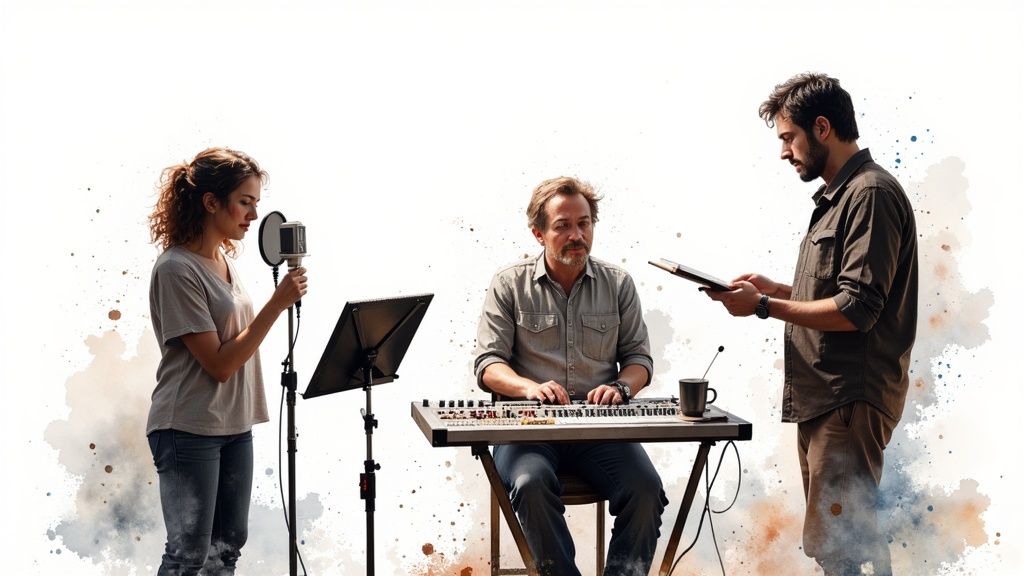
It's tempting to think that great audio is a one-person job, but that’s rarely the case. Just like a film set relies on directors, cinematographers, and editors, a professional audio project is a team sport. It brings together specialists who each own a critical piece of the puzzle.
When you know who does what, the whole process starts to make a lot more sense. Think of it like building a house: you have the architect with the grand vision, the contractor managing the day-to-day, and the skilled electricians and plumbers who handle the intricate details. In the audio world, every role ensures the final track is both creatively compelling and technically sound.
At the top sits the Audio Producer, who is essentially the project's film director. They hold the vision for the final track, guiding the project from a rough idea all the way to a finished master. The producer’s job is to shape the song’s arrangement, coach artists to pull out their best performances, and make the big creative calls that define the track’s emotional impact.
Producers wrestle with the important questions. Does this song need a new chord progression? Should the chorus hit harder? Is the vocal performance really selling the lyrics? Ultimately, the producer is the one responsible for the entire feel and sound of the record.
While the producer steers the creative ship, a team of engineers is down in the engine room, handling all the technical heavy lifting. These are highly specialized roles focused on capturing, sculpting, and polishing the sound with absolute precision.
It's true that in a modern home studio, one person often wears all of these hats. But even if you're flying solo, understanding the distinct mindset for each role will make your workflow more organized and your final product more professional.
This division of labor is especially important for spoken-word projects like podcasts, where clarity and clean editing are king. If you're diving into that world, our guide to the best podcast editing software can help you find the right tools, whether you’re a one-person show or working with a team.
Artificial intelligence isn't some far-off concept for the recording studio anymore; it's here now, working as a powerful collaborator that’s genuinely changing how we produce audio. Instead of replacing producers, think of AI as an essential assistant that handles tedious technical work and opens up creative doors we couldn't have imagined a few years ago.
Picture AI as a tireless junior engineer, always ready with smart suggestions to speed up your workflow. You'll find this technology in smart EQs that help balance frequencies, AI mixing assistants that give you a solid starting point for a mix, and even mastering tools that can analyze your track and apply a professional sheen in minutes.
The impact is impossible to ignore. The global market for music production software is set to grow by hundreds of millions of dollars in the next few years, with a compound annual growth rate of nearly 8%. A huge part of that growth comes from AI tools that simplify complex tasks like sound design and composition, making it easier for more people to get professional results. You can read the full analysis on this market transformation to dig deeper into the numbers.
For me, one of the most exciting areas where AI is making waves is in sound generation. For years, finding the perfect sound effect meant digging through massive, expensive libraries for hours, only to settle for something that was close enough. AI sound effect generators completely flip that frustrating process on its head.
A tool like SFX Engine lets producers create truly unique, royalty-free SFX just by describing what they want to hear. Instead of searching for "footsteps on gravel," you can generate your own custom version, tweaking it until it fits your scene perfectly. This is a game-changer. It's not just about saving time; it's about unlocking a new level of creative freedom. Our guide on how to create sounds shows just how easy and intuitive it is to get started.
AI's true power in audio production lies in its ability to remove creative friction. By automating repetitive or highly technical tasks, it frees up producers to focus on what truly matters: the performance, the emotion, and the story.
AI's reach goes far beyond music, too. One of the more fascinating applications is in content creation, where models can now turn text into podcast with AI automatically. This creates entirely new possibilities for bloggers, writers, and businesses to convert their articles and posts into engaging audio without needing a studio or a microphone.
Whether it’s un-mixing a finished stereo track back into its individual instrument stems or generating entirely new musical ideas from scratch, AI is quickly becoming a core part of the modern audio toolkit. It’s making sophisticated processes faster and more intuitive, ultimately allowing a creator’s artistic vision to take center stage.
Stepping into audio production can feel like learning a new language. There are so many terms, tools, and workflows that it's easy to get lost. It's totally normal to have a million questions when you're just starting out.
Let's tackle some of the most common hurdles and points of confusion. Getting these answers straight will help you build a solid foundation and let you focus on what really counts: making cool sounds.
Absolutely not. This is probably the biggest myth in the entire field. You don't need a room packed with blinking lights and fancy gear to make great audio. Honestly, you can get a surprisingly long way with just three things: a computer, a decent pair of headphones, and a Digital Audio Workstation (DAW).
Many of the top DAWs have free trials or "lite" versions that are incredibly powerful and more than enough to learn the ropes. Down the road, a good audio interface and a versatile microphone are fantastic first upgrades, but they aren't entry fees. The real secret is to just start making things with what you've got. You can always add to your setup later.
Don’t let "gear acquisition syndrome" stop you before you even begin. Your creativity and desire to learn are your most powerful tools. A thoughtful, well-executed track made on a laptop will always beat a sloppy, uninspired one made in a pro studio.
This one trips up almost everyone at first, but it makes perfect sense once you understand the focus of each step. Think of it like this: mixing is about making sure all the individual ingredients in a recipe work together, while mastering is about the final presentation of the finished dish.
When you're mixing, you're deep in the project, working with every individual track—the vocals, drums, bass, synths, and sound effects. Your goal is to balance their levels, position them in the stereo field (panning), and add effects to make them all fit together into one cohesive stereo file. It's all about the relationship between the parts.
Mastering is the final coat of varnish. It happens after the mix is finished and you have that single stereo file. The mastering engineer takes that file and applies subtle adjustments to the overall tone, loudness, and stereo width. Their job is to ensure the track sounds polished, professional, and consistent across all kinds of speakers, from earbuds to car stereos.
You can pick up the fundamentals fairly quickly. In a few weeks of dedicated effort, you can definitely learn how to record some audio, do basic edits, and put together a simple mix. But becoming truly proficient—developing a signature sound and a deep understanding of the craft—is a lifelong pursuit. It's a journey, not a destination.
The absolute best way to get better is by finishing what you start. It’s so easy to get caught in a loop, endlessly tweaking a single drum sound or vocal take. Resist that urge. Make it your goal to finish tracks, even if you think they’re imperfect. Every project you complete teaches you invaluable lessons that you'd never learn otherwise. Your first track won't win any awards, and that's completely fine. Your tenth will be better, and your hundredth, better still.
Ready to stop searching for the perfect sound and start creating it? SFX Engine gives you the power to generate custom, royalty-free sound effects with AI. Just describe what you hear in your head and bring it to life instantly. Start creating unique audio for your projects today at sfxengine.com.